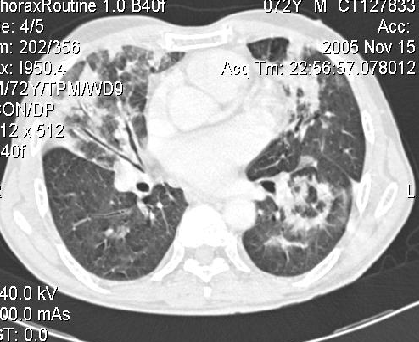Bronchiolitis obliterans organizing pneumonia (BOOP)
Imaging -
Plain radiograph findings include the following:
- Bilateral or unilateral, patchy, alveolar, airspace consolidation is revealed, often subpleural and peribronchial in location and mainly in the lower zones.
- Consolidation is nonsegmental and commonly 2-6 cm in diameter.
- An air bronchogram may be present.
CT and high-resolution CT findings include the following:
- Patchy ground-glass opacities in a subpleural and/or peribronchovascular distribution (80%)
- Bilateral basal airspace consolidation (71%)
- Bronchial wall thickening and cylindrical bronchial dilatation in areas of air bronchogram (71%)
- Centrilobular nodules 3-5 mm in diameter in approximately one half of patients
- Mediastinal lymphadenopathy (27%)
- Small nodular opacities measuring 1-10 mm in diameter, typically ill defined (50%)
Organizing pneumonia is characterized by the presence of granulation tissue in the distal air spaces. When associated with granulation tissue in the bronchiolar lumen, organizing pneumonia is qualified by the term bronchiolitis obliterans (BO). Hence, the term bronchiolitis obliterans organizing pneumonia (BOOP) is used.
Approximately one half of cases of BOOP are idiopathic. A variety of conditions are associated with BOOP are :
1.Radiation therapy
2.Infection can be caused by influenza A virus, measles virus, parvovirus B19, HIV, Chlamydia species, Plasmodium vivax, or Plasmodium malariae.
3.Drugs and toxins: BOOP is associated with exposure to minocycline; gold; cephalosporin; acebutolol; sulfasalazine; mesalazine; bucillamine; interferon beta-1a; nitrofurantoin; amiodarone; ticlopidine; carbamazepine; phenytoin.
BOOP may be associated with various connective tissue disorders and immunocompromised state.



